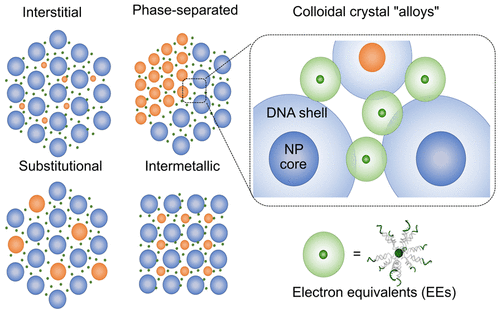当前位置:
X-MOL 学术
›
J. Am. Chem. Soc.
›
论文详情
Our official English website, www.x-mol.net, welcomes your
feedback! (Note: you will need to create a separate account there.)
Colloidal Crystal “Alloys”
Journal of the American Chemical Society ( IF 14.4 ) Pub Date : 2019-12-16 , DOI: 10.1021/jacs.9b11109 Shunzhi Wang , Jingshan S Du , Nicolas J Diercks , Wenjie Zhou , Eric W Roth , Vinayak P Dravid , Chad A Mirkin
Journal of the American Chemical Society ( IF 14.4 ) Pub Date : 2019-12-16 , DOI: 10.1021/jacs.9b11109 Shunzhi Wang , Jingshan S Du , Nicolas J Diercks , Wenjie Zhou , Eric W Roth , Vinayak P Dravid , Chad A Mirkin

|
Colloidal crystal engineering with DNA has emerged as a powerful tool for precisely controlling the arrangement of nanoscale building blocks in three-dimensional superlattices, where nanoparticles densely modified with DNA can be viewed as "programmable atom equivalents" (PAEs). Although a wide variety of complementary DNA-modified nanoparticles, differentiated by size, shape, and composition, have been assembled into many "ionic" phases, the predictable formation of "alloy" phases remains elusive. Here, we describe the design of "colloidal crystal alloys" by combining gold PAEs of two different sizes (core diameters ranging from 5 to 40 nm) with complementary DNA-modified 2 nm gold nanoparticles (∼15 DNA strands/particle) that act as electron equivalents (EEs). Electron microscopy and small-angle X-ray scattering (SAXS) experiments reveal the formation of four classes of colloidal alloy equivalents: interstitial, substitutional, phase-separated, and intermetallic alloys. In these colloidal alloy phases, PAEs occupy lattice positions, while EEs stabilize the PAE lattice but do not occupy specific lattice sites. A set of chemical design guidelines emerge from this study, analogous to that of the Hume-Rothery rules, allowing for programmed synthesis of different alloy phases depending on PAE particle size ratio, DNA surface coverage, stoichiometric ratio, and thermal annealing pathways. Furthermore, we study the phase separation process via in situ SAXS experiments as well as ex situ electron microscopy, revealing the critical role of kinetics on the phase behavior in these systems.
中文翻译:

胶体晶体“合金”
DNA 胶体晶体工程已成为精确控制纳米级构建块在三维超晶格中排列的强大工具,其中用 DNA 密集修饰的纳米粒子可以被视为“可编程原子等效物”(PAE)。虽然各种互补的 DNA 修饰纳米粒子,因大小、形状和组成而异,已组装成许多“离子”相,但“合金”相的可预测形成仍然难以捉摸。在这里,我们通过将两种不同尺寸(核心直径范围为 5 到 40 nm)的金 PAE 与互补的 DNA 修饰的 2 nm 金纳米粒子(~15 个 DNA 链/粒子)结合来描述“胶体晶体合金”的设计。电子当量 (EE)。电子显微镜和小角度 X 射线散射 (SAXS) 实验揭示了四类胶体合金等效物的形成:间隙合金、置换合金、相分离合金和金属间合金。在这些胶体合金相中,PAEs 占据晶格位置,而 EEs 稳定 PAE 晶格但不占据特定的晶格位置。本研究中出现了一组化学设计指南,类似于 Hume-Rothery 规则,允许根据 PAE 粒径比、DNA 表面覆盖率、化学计量比和热退火途径对不同合金相进行程序化合成。此外,我们通过原位 SAXS 实验以及非原位电子显微镜研究相分离过程,揭示了动力学对这些系统中相行为的关键作用。
更新日期:2019-12-16
中文翻译:

胶体晶体“合金”
DNA 胶体晶体工程已成为精确控制纳米级构建块在三维超晶格中排列的强大工具,其中用 DNA 密集修饰的纳米粒子可以被视为“可编程原子等效物”(PAE)。虽然各种互补的 DNA 修饰纳米粒子,因大小、形状和组成而异,已组装成许多“离子”相,但“合金”相的可预测形成仍然难以捉摸。在这里,我们通过将两种不同尺寸(核心直径范围为 5 到 40 nm)的金 PAE 与互补的 DNA 修饰的 2 nm 金纳米粒子(~15 个 DNA 链/粒子)结合来描述“胶体晶体合金”的设计。电子当量 (EE)。电子显微镜和小角度 X 射线散射 (SAXS) 实验揭示了四类胶体合金等效物的形成:间隙合金、置换合金、相分离合金和金属间合金。在这些胶体合金相中,PAEs 占据晶格位置,而 EEs 稳定 PAE 晶格但不占据特定的晶格位置。本研究中出现了一组化学设计指南,类似于 Hume-Rothery 规则,允许根据 PAE 粒径比、DNA 表面覆盖率、化学计量比和热退火途径对不同合金相进行程序化合成。此外,我们通过原位 SAXS 实验以及非原位电子显微镜研究相分离过程,揭示了动力学对这些系统中相行为的关键作用。






























 京公网安备 11010802027423号
京公网安备 11010802027423号